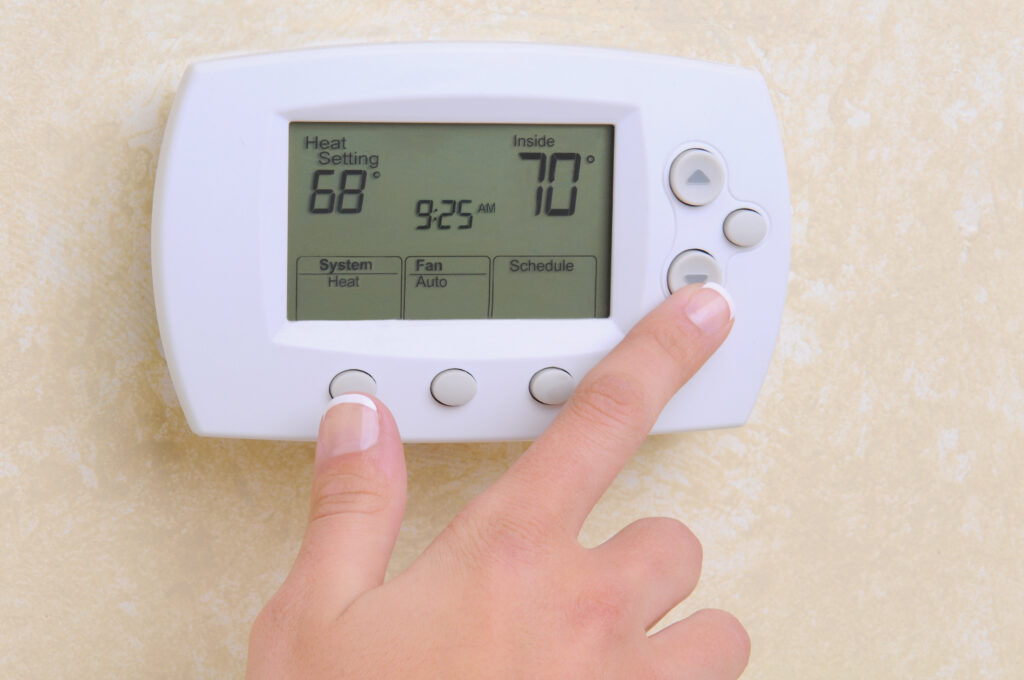AC Cycling Every Few Minutes? It Might Not Be the Thermostat
If your air conditioner turns on, then off, then on again within minutes, cycling behavior, it’s easy to assume the thermostat is broken. But frequently, that’s not actually the issue. Many homes in Downey, CA experience this when the root cause lies elsewhere: airflow issues, refrigerant levels, dirty coils, or an oversized unit. You don’t want wasted energy or a failing AC unit. Let’s walk through what causes short cycling, how to spot the real issue, and what you can do to fix it.

Why Short Cycles Are a Problem
Here’s why an AC that cycles too quickly makes cooling less effective and more expensive:
- It never stays on long enough to dehumidify your home, leading to sticky, uncomfortable air.
- It increases your electric usage because a startup draws more power than steady cooling.
- Parts wear out faster when the compressor and fan motor turn on and off too often.
- You might think your thermostat is malfunctioning and spend money on a needless fix.
If the thermostat isn’t the culprit, where should you look next?
Cause #1: Dirty or Blocked Air Filters and Coils
In Downey’s dusty climate, filters get clogged fast. When airflow can’t move through, the system can’t absorb heat properly. The result: the evaporator coil inside the house gets too cold, frost forms, and the AC shuts off quickly.
- That cold coil also causes the system to shut down before worthwhile cooling occurs.
- As soon as the thermostat hits the set temperature, even briefly, it cycles off again.
Changing your filter and cleaning coils regularly gives your system a chance to run properly.
Cause #2: Improper Refrigerant Charge
If your AC doesn’t have enough refrigerant (or has too much), it won’t pull heat from your home correctly. Low refrigerant leads to pressure issues and ice buildup. Too much causes uneven cooling and inconsistent cycling.
- Most homeowners confuse refrigerant loss with simply needing more each year.
- It’s often a leak in the copper line. That leak affects pressure and causes the system to shut down prematurely.
- After repair and recharge, the AC may run longer and cool more efficiently.
Only a trained technician should add or adjust refrigerant levels.
Cause #3: Oversized System for the Space
When you install a high-efficiency AC system without proper sizing, the unit cools too fast and shuts off before running through a full cycle.
- A large unit may make the room chilly fast, but humidity stays high because it didn’t run long enough.
- You get frequent, brief cycles across the day. That’s hard on motors and compressors.
- Sizing should match your home’s square footage, insulation levels, ceiling height, and sunlight exposure.
If your utility bills stay high despite a new unit, improper sizing might be to blame.
Cause #4: Faulty or Malfunctioning Safety Switches
Modern AC units include safety sensors, like a pressure switch or freeze sensor, that shut the system off if internal conditions look dangerous.
- A dirty evaporator coil may cause the freeze sensor to trip too early.
- Blocked drain lines can trigger a safety switch that stops the system to avoid leaks.
- A failing pressure switch might misread normal conditions as high pressure and shut the system immediately.
These sensors protect your unit, but when one malfunctions, your AC won’t run properly.
Cause #5: Blocked Condenser Unit Outside
Your outdoor unit needs proper airflow to release heat. Plants, debris, or even dust buildup can restrict airflow, causing the system to overheat quickly.
- The AC cycles off to protect itself, even if the thermostat isn’t reached.
- Dirty coils reduce efficiency drastically, making your system work harder yet run shorter cycles.
- Cleaning around the condenser improves performance and reduces cycling.
Keep six inches of space clear around your condenser to let air flow freely.
Why Checking the Thermostat Can Wait
While a defective thermostat can cause cycling, it’s wise to rule out other causes first:
- A thermostat only controls on/off based on temperature, it doesn’t measure airflow or refrigerant.
- You might replace an expensive thermostat, only to find the issue continues.
- Professionals test for cycling behavior before swapping that box out.
We only recommend thermostat replacement once other system components have been checked out.
What to Do if Your AC Short Cycles
Here’s a step-by-step DIY checklist before calling for help:
- Change the filter and look for restricted airflow.
- Inspect the outdoor condenser, clear away debris, and clean the coils.
- Monitor indoor temperature and humidity, bubbling or frosty refrigerant lines?
- Listen: Is the system shutting off before reaching the set temperature?
- Call for professional diagnostics if you continue to notice short cycles.
How Downey Plumbing Heating & Air Conditioning Diagnoses These Issues
When you reach out, we follow a clear approach:
- We check the filter age and airflow across evaporator coils.
- We inspect refrigerant pressure and look for freeze or pressure sensor faults.
- We measure the voltage draw on the compressor and fan motors.
- We clean coils and flush blocked drain lines.
- We test-run the system and monitor run times and cycling behavior.
Our goal is to fix the root cause, not just replace a thermostat.
Preventive Measures to Keep Your AC Running Smoothly in Downey
After a repair, here’s how to avoid short cycling again:
- Change filters every 1–3 months (depending on dust load).
- Trim vegetation and clean around the outdoor unit.
- Schedule annual maintenance tune-ups before summer.
- Monitor your bill: sudden spikes often mean cycling or inefficiency.
- Replace aging systems before damage causes early shutdowns.
These steps preserve comfort and maximize energy savings.
Is your AC turning on and off too quickly? Call Downey Plumbing Heating & Air Conditioning at 562-646-1221 to diagnose and fix cycling issues fast and right.



